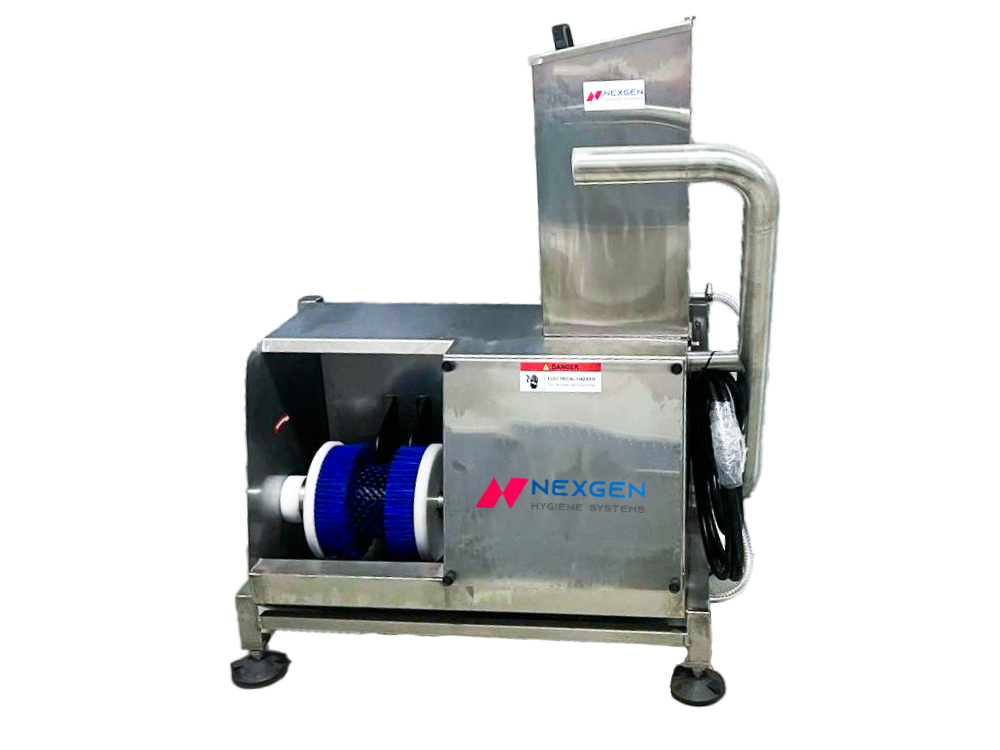Compact footprint fits easily into tight entrances or corridor transitions.
Standalone Sole Cleaning
The Standalone Sole Cleaning Machine offers efficient footwear hygiene in environments where contamination control starts at the floor. Designed for compact spaces and fast-paced operations, it removes dirt and organic residues from shoe soles using rotating brushes and optional disinfectant dosing. Ideal for food production, pharmaceutical areas, packaging facilities, and any workspace with hygiene zoning, this unit operates without needing a full hygiene station-making it a perfect fit for narrow corridors, side entry points, or modular setups.
Key Features
1
Space-Saving Design
2
Rotating Sole Brushes
High-performance brushes clean the entire sole surface while the user walks over or stands on the unit.
3
Optional Disinfectant Dosing
Can be equipped with disinfectant application for added hygiene control.
4
Stainless Steel Construction
Built entirely from AISI 304 stainless steel for durability, corrosion resistance, and easy sanitation.
5
Plug-and-Play Installation
Quick setup with standard water and power connections—no complex integration required.
6
Sensor-Activated or Manual Operation
Available with foot sensor or timed activation for hands-free use.
Benefits of Standalon Sole Cleaning
Efficient Sole Cleaning
Removes dirt and contaminants from soles before entering clean areas.
Compact and Flexible
Ideal for small facilities or side entrances without full hygiene stations.
Low Maintenance Design
Easy to clean, service, and refill-reduces downtime.
Compliance Support
Helps meet hygiene protocols in food and pharma facilities.
Touch-Free Options
Reduces contact for better cross-contamination control.

Technical Specifications
-
Material: AISI 304 stainless steel
-
Brushes: 1 or 2 rotating nylon brushes (depending on model)
-
Operation: Sensor-activated or manual switch
-
Disinfectant Dosing: Optional, adjustable through integrated dosing system
-
Drainage: Built-in with connection to waste water
-
Power Supply: 230 V / 50 Hz
-
Water Supply: Standard connection with flow control
-
Dimensions: Approx. 700 mm (L) x 600 mm (W) x 350 mm (H)
-
Installation: Free-standing or floor-mounted
-
Cleaning Time: 3–5 seconds per user
Industry Applications
Food Processing
Pharmaceutical Manufacturing
Logistics & Packaging Areas
Commercial Kitchens & Central Processing Units
One Step Closer to HACCP & GMP Compliance
Let's help you close the gap in entry point hygiene with a simple solution.
FAQs
Frequently Asked Questions
What is a standalone sole cleaning machine?
A standalone sole cleaning machine is a compact device that removes dirt and contaminants from footwear soles before entering hygiene-critical zones, without needing a full hygiene station.
How does a sole cleaning machine work?
Users walk over or stand on the unit while rotating brushes clean the soles. Some models also apply disinfectant automatically during the cleaning process.
Where should a sole cleaning unit be installed?
It should be installed at entry points to cleanrooms, food processing zones, or hygiene-controlled areas to prevent dirt from entering critical spaces.
Does it require water and power connections?
Yes. Most models require a standard 230V power supply and a basic water connection for brush rinsing and optional disinfectant application.
Can it apply disinfectant to the soles?
Yes. Models with dosing systems automatically apply disinfectant to enhance hygiene during cleaning.
How long does it take to clean soles?
Each cleaning cycle takes about 3 to 5 seconds per user, depending on the degree of contamination.
What types of shoes can it clean?
It is suitable for cleaning standard safety shoes, boots, and work footwear commonly used in industrial and food environments.
How often do the brushes need to be replaced?
Brush replacement depends on usage, but most are durable enough for extended use and easy to clean or replace as needed.
Does it comply with hygiene standards?
Yes. It supports hygiene protocols for HACCP, GMP, FSSC 22000, and other food and pharma safety standards.
Can it be used in wet or cold environments?
Yes. The stainless steel construction is corrosion-resistant and suitable for damp or temperature-controlled zones.
How much space does it take up?
Most models are compact, with an average footprint of about 700 x 600 mm, ideal for narrow corridors and side entrances.

